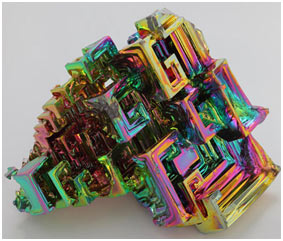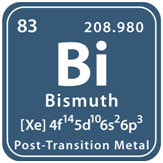Introduction
- The chemical element Bismuth is a metal present in group number 15 of the periodic table.
- Its atomic number is 83 and its atomic mass is 208.98.
- Bismuth has 83 electrons in a single neutral atom.
- It contains 83 protons and 126 neutrons in its nucleus.
- Bismuth is represented by the symbol “Bi”.
Naming and History
The name bismuth is most probably the Latinized form of the German word “Weissmuth” which means white substance. It was possibly due to its white oxide. The name later changed to “Wisuth” and “Bisemutum”.
- Agricola and Casper Neuman
Bismuth was discovered around 1400 AD. It was confused with lead or considered some form of lead. In the 1500s Agricola found that it was different metal. In the 1700s, Casper Neuman also showed it different metals.
- Claude Geoffrey
French chemist, Claude Geoffrey in 1753, finally proved that bismuth was a different element rather than any form of lead.
Occurrence of Bismuth
Bismuth occurs in nature in both native metal and ores form. The main ores of bismuth are bismuthimite and bismite. It can also be obtained from the ores of nickel, copper, lead, cobalt, silver, and tin as by-products.
The smelting of copper can be a source of bismuth. The large deposits of bismuth are found in Bolivia, Peru, Canada, Mexico, and Japan.

Properties of Bismuth
Pure bismuth metal is a crystalline, white, and brittle metal with a slight pinkish color. Bismuth salts are insoluble in water and it is stable to water and oxygen. Except for mercury, Bismuth has the lowest thermal conductivity of any metal.
It has very high electrical resistance. Bismuth is a natural diamagnetic. It has the highest value for the Hall effect. For low melting alloys, it is usually mixed with other metals such as lead, copper, cobalt, etc.
The melting point of bismuth is 271.40°C and its boiling point is 1564°C. It has a density of 9.807 grams per cubic centimeter. Bismuth exists as solid at room temperature.
Bismuth in Biological Systems
There is no significant and known role of bismuth in living organisms and living systems. It is considered to be a non-toxic element.
Uses of Bismuth
- On alloying with metals of a low melting point such as cadmium and iron, it is used in fire detection systems, fire sprinkler systems, electric fuses, solders, and extinguishers.
- In the chemical industry, it is used as a catalyst for acrylonitrile.
- It has pharmaceutical importance and uses. Bismuth carbonate is used for treating diarrhea and ulcers.
- Bismuth oxide produces yellow pigment which is used in cosmetics and paints.
- It is sometimes used in shots, shotguns, low toxicity bird shots, and fishing sinkers.
Isotopes of Bismuth
There are almost 33 known isotopes of bismuth whose mass number ranging from 185 to 217. It has no stable isotopes but Bi- 209 is considered comparatively stable which is also radioactive with a half-life of 1.9 x 10 19 years.
MCQs
- What is the atomic number of bismuth?
- A) 82
- B) 83
- C) 84
- D) 85
- Answer: B) 83
- What is the symbol for bismuth?
- A) Bs
- B) Bi
- C) Bu
- D) Be
- Answer: B) Bi
- Who is credited with proving that bismuth was a different element rather than a form of lead?
- A) Agricola
- B) Casper Neuman
- C) Claude Geoffrey
- D) Dmitri Mendeleev
- Answer: C) Claude Geoffrey
- In what form does bismuth occur in nature?
- A) Only as native metal
- B) Only as ores
- C) Both native metal and ores
- D) Neither native metal nor ores
- Answer: C) Both native metal and ores
- Which element is often obtained as a by-product during the extraction of bismuth?
- A) Gold
- B) Silver
- C) Copper
- D) Aluminum
- Answer: B) Silver
- What is the melting point of bismuth?
- A) 100°C
- B) 200°C
- C) 300°C
- D) 271.40°C
- Answer: D) 271.40°C
- Which property of bismuth makes it suitable for use in fire detection systems?
- A) High thermal conductivity
- B) Low electrical resistance
- C) Low melting point
- D) High density
- Answer: C) Low melting point
- How many known isotopes of bismuth are there?
- A) 20
- B) 25
- C) 30
- D) 33
- Answer: D) 33
- What is the chemical element number of bismuth in the periodic table?
- A) 81
- B) 82
- C) 83
- D) 84
- Answer: C) 83
- Which country has one of the largest deposits of bismuth?
- A) China
- B) India
- C) Russia
- D) Bolivia
- Answer: D) Bolivia
- What is the most probable origin of the name “bismuth”?
- A) Latin
- B) German
- C) Sanskrit
- D) French
- Answer: B) German
- Which property of bismuth makes it useful as a catalyst in the chemical industry?
- A) High thermal conductivity
- B) Low electrical resistance
- C) Low toxicity
- D) Ability to form alloys
- Answer: D) Ability to form alloys
- What is the half-life of the most stable isotope of bismuth?
- A) 1.9 x 10^5 years
- B) 1.9 x 10^10 years
- C) 1.9 x 10^15 years
- D) 1.9 x 10^19 years
- Answer: D) 1.9 x 10^19 years
- Which metal is often alloyed with bismuth to create low toxicity shot pellets?
- A) Lead
- B) Iron
- C) Cadmium
- D) Aluminum
- Answer: A) Lead
- What color is pure bismuth metal?
- A) Black
- B) Silver
- C) Pinkish
- D) Yellow
- Answer: C) Pinkish
- Which industry commonly uses bismuth as a catalyst for acrylonitrile production?
- A) Automotive
- B) Pharmaceutical
- C) Textile
- D) Aerospace
- Answer: B) Pharmaceutical
- What is the atomic mass of bismuth?
- A) 208.98
- B) 209.98
- C) 210.98
- D) 211.98
- Answer: A) 208.98
- What property of bismuth makes it a natural diamagnetic?
- A) High thermal conductivity
- B) Low electrical resistance
- C) Low toxicity
- D) Ability to form alloys
- Answer: B) Low electrical resistance
- What is the main pharmaceutical use of bismuth?
- A) Treating diabetes
- B) Treating hypertension
- C) Treating diarrhea and ulcers
- D) Treating cancer
- Answer: C) Treating diarrhea and ulcers
Frequently Asked Questions (FAQs):
- What is bismuth, and where does it sit on the periodic table?
- Bismuth is a chemical element classified as a metal and is located in group 15 of the periodic table.
- What is the atomic number and mass of bismuth?
- The atomic number of bismuth is 83, and its atomic mass is approximately 208.98.
- Who discovered bismuth, and how was it historically confused with another element?
- Bismuth was discovered around 1400 AD. Initially, it was confused with or considered some form of lead due to similarities in appearance.
- What are the main ores of bismuth, and where are large deposits found?
- Bismuth occurs in nature in both native metal and ores forms. The main ores are bismuthimite and bismite. Large deposits are found in Bolivia, Peru, Canada, Mexico, and Japan.
- What are some distinctive properties of bismuth?
- Bismuth is a crystalline, white, and brittle metal with a slight pinkish color. It has very high electrical resistance and low thermal conductivity compared to other metals.
- What are the primary uses of bismuth in various industries?
- Bismuth is used in fire detection systems, solders, pharmaceuticals (for treating diarrhea and ulcers), cosmetics (as a yellow pigment), and in shot pellets.
- Does bismuth play any significant role in biological systems?
- No, there is no known significant role of bismuth in living organisms, and it is considered non-toxic.
- How many isotopes of bismuth are known, and does it have any stable isotopes?
- There are approximately 33 known isotopes of bismuth. It has no stable isotopes, but Bi-209 is considered comparatively stable, although it is radioactive with an extremely long half-life.
Summary:
Bismuth, a metal situated in group 15 of the periodic table with an atomic number of 83 and an atomic mass of 208.98, possesses unique characteristics and a rich history. Originally derived from the German word “Weissmuth,” meaning white substance, bismuth’s naming evolution reflects its distinctive properties. Discovered around 1400 AD, it was initially confused with lead until French chemist Claude Geoffrey definitively proved its elemental distinction in 1753.
In nature, bismuth occurs in native metal and ore forms, with large deposits found in countries such as Bolivia, Peru, and Canada. Notably, it has the lowest thermal conductivity among metals and is primarily used in low melting alloys, fire detection systems, pharmaceuticals, and pigments. While bismuth has no significant role in biological systems, it has versatile applications across various industries.
With almost 33 known isotopes, bismuth lacks stable isotopes, with Bi-209 being comparatively stable but radioactive, boasting an extraordinary half-life of 1.9 x 10^19 years.
This summary encapsulates the occurrence, properties, uses, and isotopes of bismuth, highlighting its importance and versatility in science and industry. Further exploration of related topics, such as the Cori Cycle, can deepen understanding in this fascinating field.

